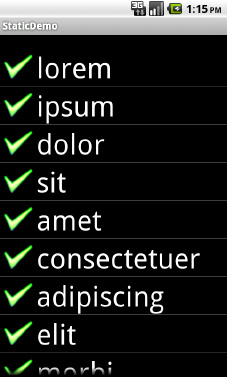The classic Android ListView is a plain list of text—solid but uninspiring. Basically, we hand the ListView a bunch of words in an array and tell Android to use a simple built-in layout for pouring those words into a list.
However, we can have a list whose rows are made up of
icons, icons and text, check boxes and text, or whatever we want. It is
merely a matter of supplying enough data to the adapter and helping the
adapter to create a richer set of View objects for each row.
For example, suppose we want a ListView
whose entries are made up of an icon, followed by some text. We could
construct a layout for the row that looks like this, found in res/layout/row.xml in the FancyLists/Static sample project:
<?xml version="1.0" encoding="utf-8"?>
<LinearLayout
xmlns:android="http://schemas.android.com/apk/res/android"
android:orientation="vertical"
android:layout_width="fill_parent"
android:layout_height="fill_parent" >
<TextView
android:id="@+id/selection"
android:layout_width="fill_parent"
android:layout_height="wrap_content"/>
<ListView
android:id="@android:id/list"
android:layout_width="fill_parent"
android:layout_height="fill_parent"
android:drawSelectorOnTop="false"
/>
</LinearLayout>
This layout uses a LinearLayout to set up a row, with the icon on the left and the text (in a nice big font) on the right.
However, by default, Android has no idea that we want to use this layout with our ListView. To make the connection, we need to supply our Adapter with the resource ID of the custom layout shown previously:
public class StaticDemo extends ListActivity {
private TextView selection;
private static final String[] items={"lorem", "ipsum", "dolor",
"sit", "amet",
"consectetuer", "adipiscing", "elit", "morbi", "vel",
"ligula", "vitae", "arcu", "aliquet", "mollis",
"etiam", "vel", "erat", "placerat", "ante",
"porttitor", "sodales", "pellentesque", "augue", "purus"};
@Override
public void onCreate(Bundle icicle) {
super.onCreate(icicle);
setContentView(R.layout.main);
setListAdapter(new ArrayAdapter<String>(this,
R.layout.row, R.id.label,
items));
selection=(TextView)findViewById(R.id.selection);
}
public void onListItemClick(ListView parent, View v,
int position, long id) {
selection.setText(items[position]);
}
}
This follows the general structure for the previous ListView sample. The key difference here is that we have told ArrayAdapter that we want to use our custom layout (R.layout.row) and that the TextView where the word should go is known as R.id.label within that custom layout.
NOTE
Remember that to reference a layout (row.xml), use R.layout as a prefix on the base name of the layout XML file (R.layout.row).
The result is a ListView with icons down the left side; in this example, all the icons are the same, as shown in Figure 1.
